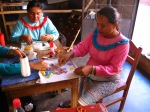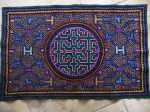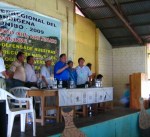The Shipibo are one of the largest tribes in Peru’s Amazon with a population of approximately 35,000 – 38,000 people. Their ancestral territory runs north and south of Pucallpa, a jungle city on the Ucayali River. The Ucayali is a large river originating from the Andes Mountains that joins the Amazon River in Northern Peru. The Shipibo live in at least 150 small communities along the Ucayali River, its tributaries and oxbow lakes. Communal living in multiple family groups is the traditional way in which the Shipibo have lived for many generations. In the past, the three groups the Shipibo, Konibo, and Xetebo were considered separate tribes. Today, they are blended into one group after years of intermarriage. They are related culturally and are of the same linguistic family, the Pano. They are most often simply referred to as the Shipibo or the Shipibo Konibo tribe.
The Shipibo were never conquered by the Inca Empire and they resisted colonization by Spanish priests who began appearing in the rainforest around 1600. The Franciscan priests eventually established a settlement in Shipibo territory by the present port city of Pucallpa. Pucallpa is in the central area of the Shipibo territory and grew rapidly in the early 1900’s during the time of the rubber boom. Then in the 1950’s missionaries descended upon the Shipibo with intense efforts to convert them to Christianity. There is still a strong missionary presence around Pucallpa.
 Despite years of invasion and colonization, the Shipibo have maintained their rich culture and traditional knowledge. The majority live in communities that are only accessible by boat and the Shipibo that live around Pucallpa are marginally acculturated with the dominate culture of Peru. For most Shipibo, Shipibo is their first language and Spanish their second. They are highly respected for their knowledge of the rainforest plant medicines and their ceremonies. The heart of the Shipibo culture is rooted in their spiritual, physical, and cultural relationship to the rainforest.
Despite years of invasion and colonization, the Shipibo have maintained their rich culture and traditional knowledge. The majority live in communities that are only accessible by boat and the Shipibo that live around Pucallpa are marginally acculturated with the dominate culture of Peru. For most Shipibo, Shipibo is their first language and Spanish their second. They are highly respected for their knowledge of the rainforest plant medicines and their ceremonies. The heart of the Shipibo culture is rooted in their spiritual, physical, and cultural relationship to the rainforest.
 The women or Shipibas, produce most of the artesania. They create beautiful pottery, textiles, and jewelry with designs that are unique to the Shipibo. The designs that they stitch and
The women or Shipibas, produce most of the artesania. They create beautiful pottery, textiles, and jewelry with designs that are unique to the Shipibo. The designs that they stitch and  paint are visual songs representing the cosmovision of the Shipibo world, an exquisite interchange between the visual representation of energy and form and the ceremonial songs called Icaros. The women are strong, beautiful, loving mothers who work hard to provide for their children.
paint are visual songs representing the cosmovision of the Shipibo world, an exquisite interchange between the visual representation of energy and form and the ceremonial songs called Icaros. The women are strong, beautiful, loving mothers who work hard to provide for their children.
The Shipibo, along with other indigenous groups in Peru have been ignored, discriminated against, and marginalized for hundreds of years. Most of Peru’s population lives in the capital, Lima, and this is where most of Peru’s wealth is invested. Shrinking territories, poor education, poor health services, and food instability due to environmental pollution and climate change have made life increasingly difficult for the Shipibo.
The development policies of the former President, Alan Garcia, accelerated the resource attack on the Amazon after the 2007 Free Trade Agreement between Peru and the United States was signed. Garcia used presidential powers to push through legislative decrees allowing multinational extraction corporations unprecedented access to the Amazon. Indigenous populations organized protests against these decrees and then on June 5, 2009, Peruvian militia was sent to a jungle town called Bagua where militia massacred thousands of peaceful, unarmed indigenous protestors. Many more indigenous were killed than was reported by the government and hundreds were wounded. The international human rights community and the United Nations denounced the Peruvian Government for this massacre. Garcia then repealed a few of the most egregious decrees and then proceeded to continue auctioning off well over 70% of the rainforest to multinational corporations, primary gas and oil. The Shipibo have been negatively affected by these policies including oil spills, degradation of the rainforest, foreign logging companies, increase in massive agribusiness such as palm tree plantations, and increased pollution of the water that is both used for drinking and fishing.
The new Peruvian President, Ollanta Humala, recently signed into law legislation that requires consultation with indigenous tribes prior to adapting administrative and legislative measures, and allowing investment projects and development plans that could affect their communities. However, the indigenous tribes have no veto power should they disapprove.
In 2009, just prior to the Bagua massacre, Shipibo leaders decided that the Shipibo must take a proactive stance to address what is happening in  their territory. The election of the first tribal council in October 2009 was the Shipibos initial effort to proactively take their future into their own hands – to become an autonomous, self-determining nation within Peru. Traditionally, each Shipibo community functions independently with its own government. This has left the Shipibo vulnerable to meet contemporary challenges as a united group. Thus, the effort to unify all of the Shipibo through a central council was an important step. Since its inception, the council has struggled to establish a clear voice and direction for the Shipibo people.
their territory. The election of the first tribal council in October 2009 was the Shipibos initial effort to proactively take their future into their own hands – to become an autonomous, self-determining nation within Peru. Traditionally, each Shipibo community functions independently with its own government. This has left the Shipibo vulnerable to meet contemporary challenges as a united group. Thus, the effort to unify all of the Shipibo through a central council was an important step. Since its inception, the council has struggled to establish a clear voice and direction for the Shipibo people.
The Shipibo are at a critical crossroads. As globalization increasingly threatens ancestral territory, the Shipibo people have to constantly renegotiate their relationship with their own culture and land. Because of the impacts on their territory, both environmentally and through colonization, the Shipibo are finding it more difficult to live traditional lifestyles dependent on the natural resources of the jungle, yet they do not have the education or skills to participate in a market economy. The Shipibo have the right to self-determination and as they move forward, they have many choices to make. As one Shipibo medico (doctor) told me, it is becoming increasingly difficult to find his medicinal plants in the rainforest. Once the land belonged to all Shipibo, but now parcels are being sold to meztisos and more Shipibo want money before allowing him to forage for the plants he needs. This sets up a complex, collision of the traditional values of social responsibility, kinship, cooperation, barter, reciprocity, sustainable resource utilization and territorial sharing against the backdrop of commercialization, land ownership, a cash economy and environmental exploitation.

Comments on: "The Shipibo" (5)
Estoy tratando de encontrar el valor de una ollita de greda Shipibo de las siguientes medidas 28 cm de largo 28 cm de ancho y 25 cm de alto. Tienen ustedes contacto con gente que venden esta Artesania para preguntar su valor.
Gracias de antemano!
I am wishing to find the value of a Terracota Shipibo pot of the following measurements 28cm long, 28 cm wide and 25 cm height. Have you contact with people who sell this type of pottery so I can ask for their value.
Thank you in advance!
That is very interesting as the Shipibo Conibo Xetebo are linguistically related to the Panoan language. There are various words for a Shipibo healer designating levels of capability. The first is Onaya. The most powerful is Muraya. Thank you for your comment.
Is there another name for a priest who represented the god, Atoya? Atoya was the most ancient deity of Peru, who lived in the mountains. We have already confirmed that the Shipibo words for the Sacred Black Drink (from holly leaves) and a village chief (orata) are the same in Creek and Panoan.
Comprehensive linguistic analysis by the People Of One Fire of some of the ancestral branches of the Creek Indians in the Coastal Plain of Georgia and South Carolina has revealed that they were actually Panoans (Shipibo, Conibo, Satibo, Kashibo) from Peru, not Muskogeans. The Muskogeans apparently migrated into the region during the Late Woodland Period and blended with existing Panoan provinces. The Swift Creek Culture was definitely Conibo in origin. What is the Shipibo word for a priest? Early French explorers in the Low Country of Georgia and South Carolina recorded Panoan speaking provinces using the word Joana for priest.
Thanks
Richard Thornton
No. We are not at all involved with artifacts – just linguistics, architecture and colonial archives.